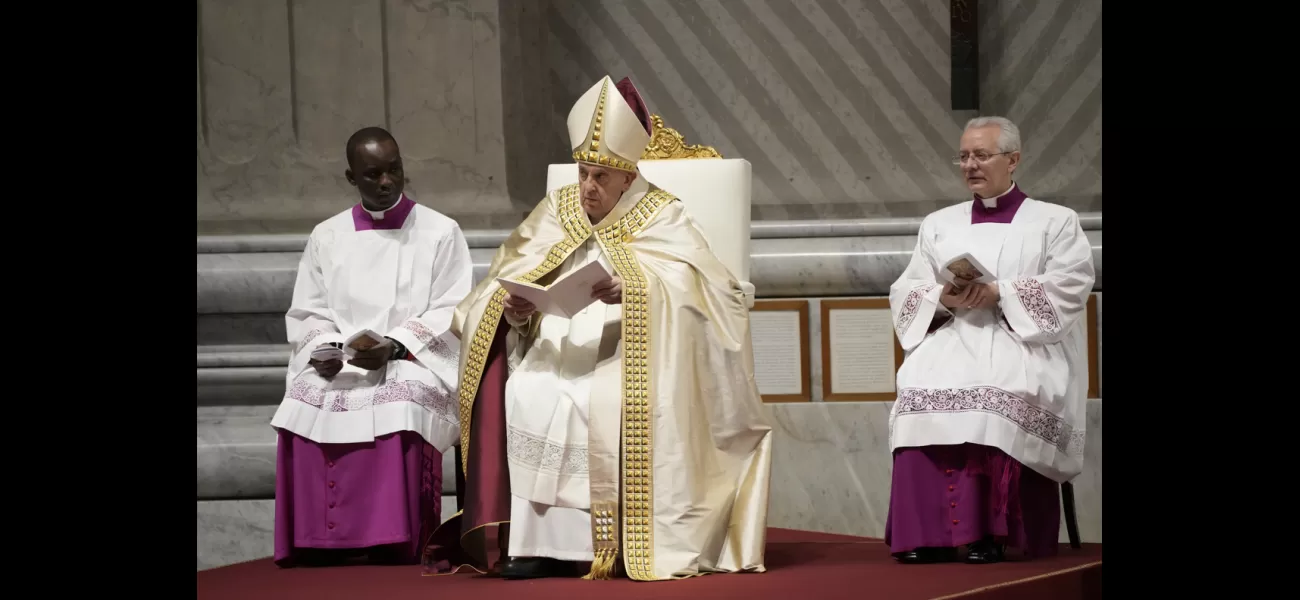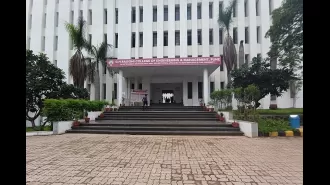Pope Francis declares 2025 as a 'Holy Year' in a formal announcement.
In 2025, Rome is gearing up for its first major pilgrimage event since 2000, with an estimated attendance of millions.
May 10th 2024.

The Vatican recently reached a significant milestone in its preparations for the 2025 Jubilee. The official decree establishing the Holy Year was promulgated, marking the start of a once-in-a-quarter-century event. This highly-anticipated event is expected to bring in around 32 million pilgrims to Rome, and has already caused a great deal of stress and inconvenience for the city's residents.
Pope Francis presided over a ceremony at St. Peter's Basilica, where the papal bull, or official edict, was read. In his vision for the year of hope, the Pope called for acts of solidarity towards the poor, prisoners, migrants, and the environment. He emphasized the need for hope in a world that has been damaged by human selfishness and plagued by fear and uncertainty.
The ceremony was attended by cardinals, bishops, and faithful followers, and it marked the beginning of the final seven months of preparations for the Jubilee. These preparations include various public works projects that must be completed by December 24th, when the Holy Door of the basilica will be opened, and the Jubilee officially inaugurated. As a new and untraditional addition, Pope Francis announced that he would also be opening a Holy Door in a prison, as a symbolic invitation for prisoners to find hope and renewed confidence for their future.
For the Vatican, the Jubilee is a long-standing tradition where faithful pilgrims make their way to Rome to visit the tombs of Saints Peter and Paul, and receive indulgences for the absolution of their sins. However, for the city of Rome, the Jubilee also presents an opportunity to utilize the significant amount of public funds, which amounts to approximately 4 billion euros, for much-needed projects to improve the city's infrastructure. In the words of Archbishop Renato Fisichella, the Vatican's point person for the Jubilee, "In a beautiful city, you live better." He also stated that the city of Rome will become even more beautiful and better equipped to serve its people, pilgrims, and tourists who will be visiting.
The first Holy Year was declared by Pope Boniface VIII in 1300, and since then, these Jubilees have been held every 25 years. However, in 2015, Pope Francis called for an interim Jubilee focused on mercy, and the 2025 edition will be the first major one since St. John Paul II's in 2000 - a significant moment for the Catholic Church as it entered the third millennium.
As with the preparations leading up to the 2000 Jubilee, the city of Rome has been overwhelmed with public works projects in anticipation for the 2025 event. Flood-lit construction sites operate around the clock, entire sections of central boulevards have been rerouted, and traffic has become even more congested in the already bustling city. The banks of the Tiber River, which runs through the city center, are now off-limits as crews work to create new parks. Piazzas are being repaved, bike paths are being mapped out, and 5G cells are being installed. The aim is to bring Rome up to par with other European capitals and make use of the significant amount of funds available, including 1.3 billion euros in special Jubilee funding and an additional 3 billion euros in public and post-pandemic EU funds.
The chaos caused by these preparations has not gone unnoticed by the city's residents and tourists. Tiziana Cafini, who runs a tobacco shop near the Pantheon, has resorted to walking to work rather than taking the bus due to the constant traffic jams. She acknowledges that the discomfort will be worth it in the end, but the wait is still far from over. In addition to the Jubilee construction, there is a separate project to extend the city's Metro C subway line into the historic center, which has been delayed due to archaeological excavations of ancient Roman ruins.
The Roman Mayor, Roberto Gualtieri, recently stated that he is satisfied with the pace of the Jubilee works, despite a delayed start due to the collapse of the government in 2022. He promised that the projects would be completed on time and acknowledged the inconvenience caused to residents and tourists. He also announced that 1000 additional taxi licenses have been approved to address the acute shortage of taxis in the city.
However, as of late last month, only two out of 231 city projects had been completed, and 13 projects had been canceled. Gualtieri assured the public that the essential projects would be completed on time, while the longer-term projects would take longer. The most significant project is the creation of a new piazza and pedestrian zone connecting Castel St. Angelo and Via della Conciliazione to St. Peter's Square. This project has caused major traffic disruptions and required the re-routing and replacement of a large underground sewage system. Despite the delays, the crews are working tirelessly to meet the deadline.
The Jubilee preparations may have tested the patience of Romans, but they have also brought a sense of excitement and anticipation for the future. As Tiziana Cafini said, "We're upset, but we're Romans, we'll make do." The city of Rome is getting ready to welcome millions of pilgrims and tourists, and with the completion of these projects, it will be better equipped to serve and accommodate its visitors. The Jubilee is not just a significant event for the Catholic Church, but also for the city of Rome, as it works towards becoming a more beautiful and livable city for its residents and visitors alike.
Pope Francis presided over a ceremony at St. Peter's Basilica, where the papal bull, or official edict, was read. In his vision for the year of hope, the Pope called for acts of solidarity towards the poor, prisoners, migrants, and the environment. He emphasized the need for hope in a world that has been damaged by human selfishness and plagued by fear and uncertainty.
The ceremony was attended by cardinals, bishops, and faithful followers, and it marked the beginning of the final seven months of preparations for the Jubilee. These preparations include various public works projects that must be completed by December 24th, when the Holy Door of the basilica will be opened, and the Jubilee officially inaugurated. As a new and untraditional addition, Pope Francis announced that he would also be opening a Holy Door in a prison, as a symbolic invitation for prisoners to find hope and renewed confidence for their future.
For the Vatican, the Jubilee is a long-standing tradition where faithful pilgrims make their way to Rome to visit the tombs of Saints Peter and Paul, and receive indulgences for the absolution of their sins. However, for the city of Rome, the Jubilee also presents an opportunity to utilize the significant amount of public funds, which amounts to approximately 4 billion euros, for much-needed projects to improve the city's infrastructure. In the words of Archbishop Renato Fisichella, the Vatican's point person for the Jubilee, "In a beautiful city, you live better." He also stated that the city of Rome will become even more beautiful and better equipped to serve its people, pilgrims, and tourists who will be visiting.
The first Holy Year was declared by Pope Boniface VIII in 1300, and since then, these Jubilees have been held every 25 years. However, in 2015, Pope Francis called for an interim Jubilee focused on mercy, and the 2025 edition will be the first major one since St. John Paul II's in 2000 - a significant moment for the Catholic Church as it entered the third millennium.
As with the preparations leading up to the 2000 Jubilee, the city of Rome has been overwhelmed with public works projects in anticipation for the 2025 event. Flood-lit construction sites operate around the clock, entire sections of central boulevards have been rerouted, and traffic has become even more congested in the already bustling city. The banks of the Tiber River, which runs through the city center, are now off-limits as crews work to create new parks. Piazzas are being repaved, bike paths are being mapped out, and 5G cells are being installed. The aim is to bring Rome up to par with other European capitals and make use of the significant amount of funds available, including 1.3 billion euros in special Jubilee funding and an additional 3 billion euros in public and post-pandemic EU funds.
The chaos caused by these preparations has not gone unnoticed by the city's residents and tourists. Tiziana Cafini, who runs a tobacco shop near the Pantheon, has resorted to walking to work rather than taking the bus due to the constant traffic jams. She acknowledges that the discomfort will be worth it in the end, but the wait is still far from over. In addition to the Jubilee construction, there is a separate project to extend the city's Metro C subway line into the historic center, which has been delayed due to archaeological excavations of ancient Roman ruins.
The Roman Mayor, Roberto Gualtieri, recently stated that he is satisfied with the pace of the Jubilee works, despite a delayed start due to the collapse of the government in 2022. He promised that the projects would be completed on time and acknowledged the inconvenience caused to residents and tourists. He also announced that 1000 additional taxi licenses have been approved to address the acute shortage of taxis in the city.
However, as of late last month, only two out of 231 city projects had been completed, and 13 projects had been canceled. Gualtieri assured the public that the essential projects would be completed on time, while the longer-term projects would take longer. The most significant project is the creation of a new piazza and pedestrian zone connecting Castel St. Angelo and Via della Conciliazione to St. Peter's Square. This project has caused major traffic disruptions and required the re-routing and replacement of a large underground sewage system. Despite the delays, the crews are working tirelessly to meet the deadline.
The Jubilee preparations may have tested the patience of Romans, but they have also brought a sense of excitement and anticipation for the future. As Tiziana Cafini said, "We're upset, but we're Romans, we'll make do." The city of Rome is getting ready to welcome millions of pilgrims and tourists, and with the completion of these projects, it will be better equipped to serve and accommodate its visitors. The Jubilee is not just a significant event for the Catholic Church, but also for the city of Rome, as it works towards becoming a more beautiful and livable city for its residents and visitors alike.
[This article has been trending online recently and has been generated with AI. Your feed is customized.]
[Generative AI is experimental.]
0
0
Submit Comment





